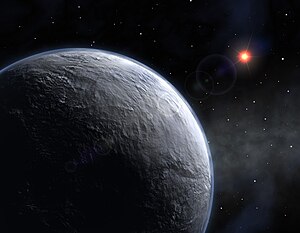

This is a list of the coolest exoplanets known, specifically those with temperatures lower than −75 °C (198 K). Planets from the Solar System were also included for comparison purposes.

| Image (or artistic representation) |
Name | Temperature | Mass
(M⊕orMJ) |
Method[a] | Notes | References |
|---|---|---|---|---|---|---|
 |
OGLE-2005-BLG-390Lb | -223 °C (50 K) | 5.5 M🜨 | Teq | The coldest known exoplanet, with a temperature lower than the melting points of oxygen and nitrogen. [b] | [4] |
| OGLE-2005-BLG-071L b | -218 °C | 3.8 MJ | [5] | |||
 |
PSR B1620-26 b | -201.2 °C | 2.5 MJ | One of the oldest exoplanets known, with an age of 12.7 billion years.[note 1] | [6] | |
 |
Neptune (For reference) | -200 °C | 17.15 M🜨 | [7][8] | ||
 |
Uranus (For reference) | -195 °C | 14.54 M🜨 | [7][9] | ||
| TOI-969 c | -176.6+6.8 −5.8 °C |
Teq | [10] | |||
 |
HIP 11915 b | -155 °C | 0.99 MJ | A Jupiter analog. | [c] | |
| GJ 414 A c | -148.3±13.5 °C | 53.83 M🜨 | [11] | |||
| HD 191939 f | < -148 °C | 2.1 MJ | [12] | |||
 |
Saturn (For reference) | -140 °C | 95 M🜨 | [7][13] | ||
| Kepler-167 e | -138.6±5 °C | 1.01 MJ | Teq | [14] | ||
| HD 115954 b | -128.1+8.1 −13 °C |
8.29 MJ | [15] | |||
 |
Gliese 777 b | -123+26 −27 °C |
1.8 MJ | [16] | ||
 |
Epsilon Eridani b (AEgir) | -123 °C | 0.63 MJ | [17][18] | ||
| HD 164922 b | -114 °C | 0.365 MJ | [19][20] | |||
| Teegarden's Star d | -114 °C | >0.82 M🜨 | One of the nearest exoplanets. | [21] | ||
 |
Jupiter (For reference) | -110 °C | 317.8 M🜨 (1 MJ) | [7][22] | ||
 |
WD 1856+534 b | -110+14 −18 °C |
<13.8 MJ | Teq | [23] | |
 |
PSR B1257+12 d (Phobetor) | -104 °C | 3.9 M🜨 | One of the first exoplanets discovered. | [24] | |
 |
HR 5183 b | -102+5.2 −5.1 °C |
3.23 MJ | A highly-eccentric orbit planet. | [25] | |
 |
TRAPPIST-1h | -101.5 °C | 0.326 M🜨 | [26] | ||
| TOI-4010 e | -99+8 −6 °C |
2.18 MJ | [27] | |||
| HATS-59 c | -97.1±6.4 °C | 12.7 MJ | [28] | |||
| HD 86226 b | -97±4 °C | 0.45 MJ | [29] | |||
| GJ 1002 c | -91.3±5.2 °C[d] | 1.36 M🜨 | Orbits within its star's habitable zone. | [30] | ||
| EPIC 248847494 b | -90+25 −18 °C |
<13 MJ | [31] | |||
| Kepler-421b | -88.2+8.6 −4.8 °C |
The transiting exoplanet with the longest orbital period. (704 days)[32] | [33] | |||
| HD 192310 c | -88 °C | 24 M🜨 | [34] | |||
 |
Kepler-16b | -85 °C | 0.333 MJ | Acircumbinary planet. | [35] | |
 |
Kepler-186f | -85 °C[e] | 1.44 M🜨 | Potentially habitable | [36][37] | |
| TOI-4600 c | -82±6 °C | <9.27 MJ | [38] | |||
 |
PSR B1257+12 c (Poltergeist) | -80 °C | 4.3 M🜨 | One of the first exoplanets discovered. | [39] | |
 |
Gliese 876 b | -79 °C | 2.66 MJ | [40][41] | ||
 |
TRAPPIST-1g | -75.8 °C[f] | 1.321 M🜨 | Potentially habitable | [26][36][42] |
These exoplanets have not been confirmed.
| Image
(Or artistic representation) |
Name | Temperature | Mass[g] | Method[a] | Notes | References |
|---|---|---|---|---|---|---|
 |
Proxima Centauri c | -234.2 °C (38.8 K) | 7 M🜨 | Teq | [43][44] |
{{cite web}}: CS1 maint: archived copy as title (link)